 |
 |
 |
| |
Dyslipidemia & Body Changes in Vertically Infected Children & Youth on PI ART: preliminary results of PACTG 1045
|
| |
| |
Reported by Jules Levin
9th Intl Workshop on Adverse Drug Reactions and Lipodystrophy in HIV, Sydney, Australia July 2007
Grace Aldrovandi, Jane Lindsey, Denise Jacobson, Barbara Heckman, Amanda Zadzilka, Elizabeth Sheeran, Jack Moye, Peggy Borum, William A. Meyer III, Dana Hardin, Ellen DeCarlo, Kathleen Mulligan
for the Pediatric AIDS Clinical Trials Group P1045 team
OBJECTIVES/STUDY DESIGN
Objective: To compare the distribution and prevalence of metabolic and morphologic outcomes in vertically-infected youth using PI- and non PI-containing regimens with those in seronegative controls
Study design: Vertically infected children and youth (ages 7-24) were randomly selected from strata defined by Tanner stage and class of ART at 37 PACTG sites; seronegative controls matched for Tanner stage, sex and race/ethnicity were selected at the same clinics (37 different sites)
Measurements: Fasting lipids, 2-h OGTT, DXA with central analysis, anthropometry, medical and antiretroviral history by interview and chart review.
STUDY GROUPS
PI (N=161): On PI-containing regimen ≥12 months
No PI (N=79): On ART but with <2 weeks lifetime exposure to PI and no PI use in past 12 months
HIV- (N=146): Seronegative controls
AUTHOR SUMMARY
--In this group of perinatally infected children, there was a high prevalence of lipid abnormalities, especially elevated TG, in those on PI-containing regimens.
--Unadjusted fasting insulin levels were about 40% higher in both HIV-infected groups, but relatively few subjects had abnormal fasting or 2-h glucose.
--Total and limb fat were lower in both HIV+ groups, compared with HIV-negative controls; trunk fat was lower in the No PI group only but lean body mass was not lower however in the HIV= groups
--Taken together, dyslipidemia and insulin resistance may accelerate the lifetime risk of cardiovascular disease in this population with extensive exposure to ART, that is likely committed for lifetime to ARTs
--Kathy Mulligan stressed these are preliminary results
DEMOGRAPHIC CHARACTERISTICS
Median age is about 11.9 yrs in HIV-negatives, 12.9 yrs in No PI group, and 12.4 in the PI group. . Roughly equal number of boys and girls in each group. Over 50% African-Americans in each group, about 30% Hispanic and the remainder Caucasian. By design they had equal representation across three groups of Tanner strata (Tanner 1, Tanner 2-3, Tanner 4-5).
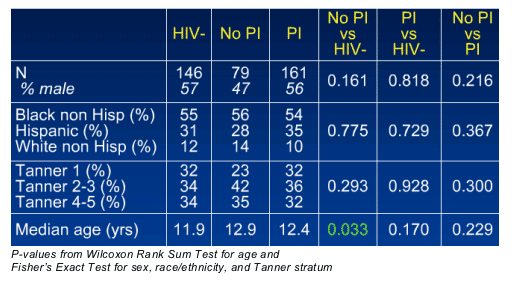
HIV DISEASE STATUS
The PI group appears to be more advanced. Although the current CD4 counts were similar (640 in No PI group, 668 in PI group, and current RNAs are similar), nadir CD4 was lower in PI group (290 vs 387), the peak RNA was higher in PI group (156,000 vs 34,972), and more CDC stages B and C in PI group.
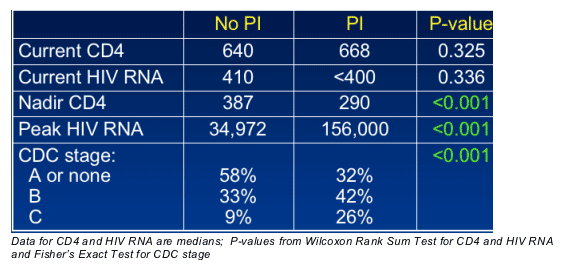
ART USE
These are kids with significant ART histories. The average age was 12-13 yrs and ART use was for 9-10 yrs. There is a trend for longer ART use in PI group: average lifetime exposure is 10 yrs in PI group and 9 in No PI group. The kids were studied between Jan 2004 and Aug 2005 to put the ART use in historical perspective. In the PI group d4T or ddI plus 3TC was the more prominently used NRTI regimen while in the No PI group AZT with 3TC was more often used. Nelfinavir was more commonly used (40%) in PI group and 31% used LPV/r and there was a 27% use of RTV so about 60% of kids in PI group used RTV. EFV was more widely used in No PI group (35% vs 10%) and 55% in the No Pi group were on other ART. In the Q&A Kathy Mulligan said the kids received a range of dosing of ritonavir from between 100 and 600 mg daily (dosing was weight adjusted) so it's hard to distinguish between RTV boosting and therapeutic doses, and many kids were on Kaletra as well.
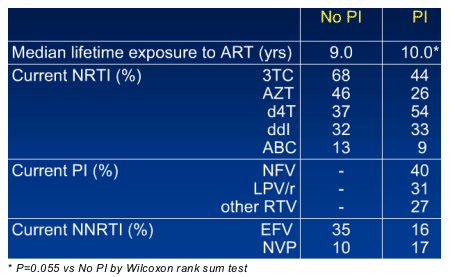
RESULTS
HEIGHT, WEIGHT, and BMI
For height and weight both HIV groups were significantly lower than HIV-negatives. For BMI kids in the PI group were significantly lower. Since kids are changing and growing constantly unlike adults, z-scores were used.
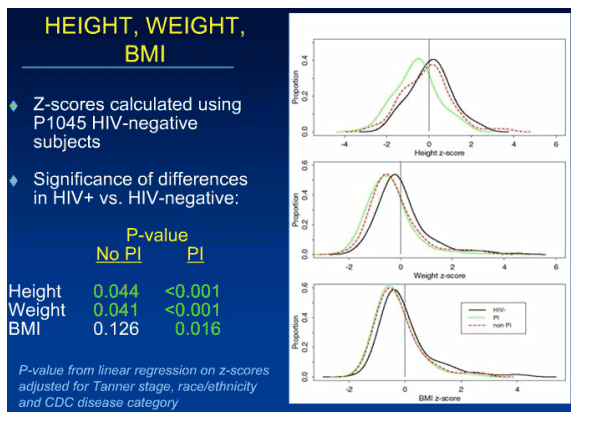
BODY COMPOSITION (DXA)
Both total fat and limb fat are significantly lower in both HIV+ groups compared to HIV-negatives. For trunk fat the No PI group was significantly lower than the HIV-negatives. But for the PI group trunk fat was not significantly different than the HIV-negatives and this was notable because the PI group had a lower overall BMI than the HIV-negatives. Of note, for lean body mass neither HIV+ group was significantly different from the HIV-negatives suggesting difference in weight and BMI between the HIV positives and negatives was due to differences in fat in the HIV-positives.
So what do these z-scores mean in terms of absolute values for fat? The difference between HIV-positives and negatives in total fat was 2 to 2.5 kgs and this was more or less evenly distributed between trunk and limb fat.
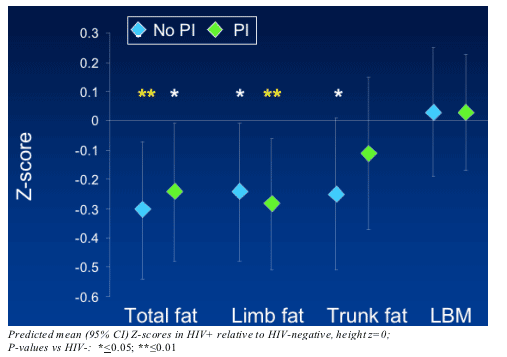
FASTING LIPIDS (unadjusted data) (here you don't have to use z-scores)
The triglycerides were significantly higher in the No PI & the PI groups compared to HIV-negatives but were double in the PI group compared to the HIV-negatives (134 vs 67). Total chol, LDL, and non-HDL were all significantly higher in the PI group compared to the HIV-negatives but not in the No PI group compared to the HIV-negatives. HDL was significantly lower in the PI group but not in the No PI group, compared to HIV-negatives. The p-values were based on unadjusted analyses but they also did the analyses with adjustments and p-values with asterisks remained significant after adjustment for Tanner, race CDC stage.
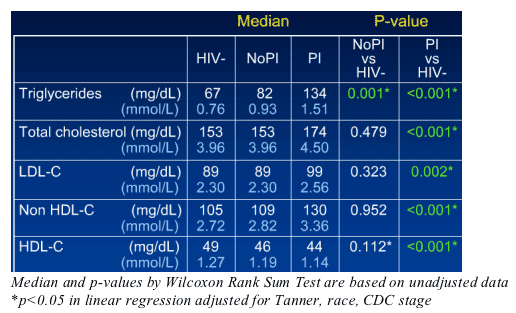
PERCENT WITH ABNORMAL LIPID VALUES*
There is no consensus for abnormal levels for kids but using the cutpoints they selected over 50% (>130 mg/dl) of kids on PIs had elevated triglycerides. For kids on No PI regimens about 10% had TG elevations above normal. For total chol, LDL, and non-HDL cholesterols kids on PIs had 20-30% of values that were elevated. For HDL-C both PI & No Pi groups had abput 10% above normal.
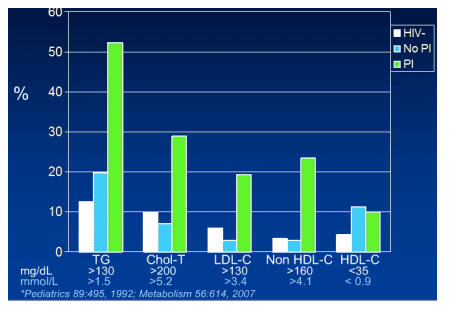
GLUCOSE and INSULIN
There was a different pattern here. Fasting glucose was similar across the 3 groups although it was significantly lower among the PI group compared to HIV-negatives. Fasting insulin was significantly higher (about 40% higher) in the both HIV groups compared to the HIV-negative group. And as a result HOMA-IR scores were higher as well. There were no significant differences in 120 minute glucose and insulin testing results between HIV negatives and positives. Again p-values here were calculated unadjusted but after adjustment for Tanner, race and CDC stage the differences between HIV negatives and positives regarding insulin were no longer significant suggesting other factors are playing major role in elevated insulin values.
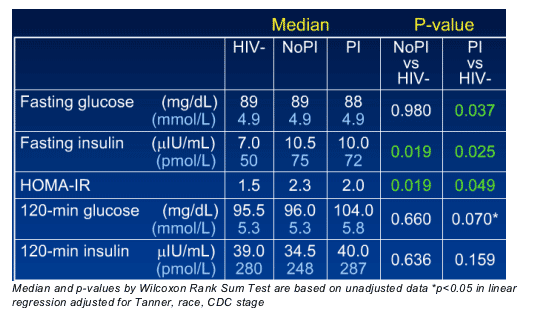
PERCENT WITH ABNORMAL GLUCOSE
There were few glucose abnormalities in fasting glucose or 2-hour fasting levels in HIV positives suggesting those elevated insulin levels were helping to keep glucose under control.
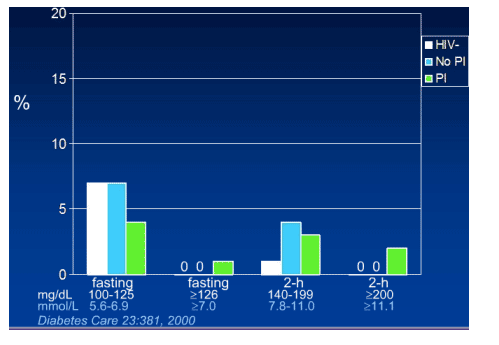
ASSOCIATIONS OF LIPID/GLUCOSE LEVELS WITH LIFETIME EXPOSURE
TO NELFINAVIR OR RITONAVIR
RTV was more significantly associated with lipid abnormalities than NLF. RTV was not significantly associated with glucose abnormalities.
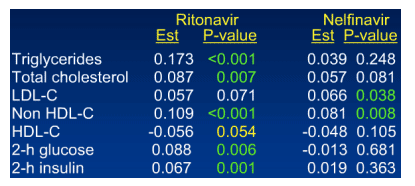
Yearly predicted change in outcome Z-score, estimated by linear regression and adjusting for race/ethnicity, Tanner stratum, CDC stage, and time since starting ART. No significant associations with fasting glucose or insulin
STUDY CAVEATS
--Cross-sectional design does not allow us to draw conclusions about causality
--Although they attempted to get a representative sample by randomly selecting them from clinic populations there was a 40% refusal rate among HIV-positive subjects approached may have biased study sample
--The PI group had longer duration of exposure to ART, lower nadir CD4, higher peak HIV RNA, and a greater representation in CDC category C
--Accordingly, it is difficult to differentiate between the effects of PIs and those of more advanced disease
--Further analyses will focus on other cofactors influencing metabolic and morphologic alterations
|
| |
|
 |
 |
|
|